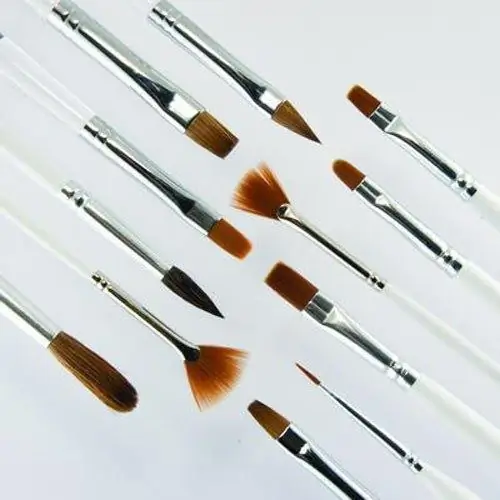Round and flat, with a wooden handle and plastic, marten and pony. The variety of shapes and types of brushes helps the artist to create masterpieces on canvas or paper. So, for example, the squirrel brush is used mainly for working with watercolor paint, and the linear brush is used for labeling.

Brush shapes
One of the most common and versatile brush shapes is round. A bundle of such a brush is fixed in a round clip, usually metal. Brushes come in a variety of sizes. A small bundle is used for miniatures and a large bundle for large landscapes. A round brush provides a uniform line of uniform thickness, although a skilled artist can vary it.
It is good to work out large areas of the composition with flat brushes, they retain a lot of paint. Brush strokes are smooth and wide.
The brush called "cat's eye" is oval or domed. Such a brush is very personal to use and can be applied in the same way as a round and flat one.
A subspecies of flat brushes are contour brushes, they have a similar shape, but the bunch is shorter and, accordingly, more elastic. These brushes are used for the oil painting technique, they are easy to make flat strokes and clear outlines.
Font brushes have a round, long tuft with a thin, sharp tip for writing and contouring. These brushes are used with liquid paints.
Retouched brushes are also a type of flat brushes, their peculiarity is the tip cut at an angle. These brushes are used to create very subtle strokes and smooth and precise transitions from one color to another. It is created with a thin and sharp tip.
Linear brushes, like font brushes, have a round, long bundle shape and are used to write inscriptions and create long, even lines. Linear brushes are shorter than font brushes, but longer and thinner than round brushes.
In addition to painting, flutes brushes are used when applying makeup, namely, powder or blush. These soft brushes are designed for free painting with watercolors. They hold a lot of water, so they can draw long, solid, uniform lines without interruption.
Fan brushes have a thin fan-shaped bundle. They are used to create subtle color stretching, color transitions and contrasts.
Types of brushes
In addition to the shapes and sizes, there is a significant difference between the types of brushes, namely, from which hair the bun is made. The most common type of brushes is squirrel. Such brushes are made from processed hairs of the squirrel tail, since it is in the tail that the longest pile is. Squirrel brushes are very soft and delicate and therefore require special care. They are used to work with watercolors or other water-based paints.
Column brushes are made from the treated pile of the column tail. These brushes are quite soft and elastic at the same time. Therefore, they are used in watercolors, as well as in oil painting to create subtle strokes.
For the production of bristle brushes, pig bristles are used, ideally the hair of a Chinese Chungking hog. These brushes are firm enough to hold paint well inside. They are used in conjunction with oil paints, acrylics, as well as dry gouache.
Quite popular tassels from goat fur. They are relatively inexpensive, easy to use, and require little maintenance. They can be used when working with watercolors, gouache, as well as in hot techniques.
The badger brush is ideal for working with oil and acrylic paints. The hair of such a brush has a peculiarity - a light tip and a dark stripe in the middle. These brushes are often made in fan and flitz shapes.
Less popular are pony, marten, weasel, and bovine hair brushes, which are made from the fur of the corresponding animals and are used, as a rule, with liquid paints.
Bear, ear brushes, as well as wolf, sable, magnust and synthetics brushes are also found in the working arsenal of artists, but they are not as popular as the above types.
There are also shapers - rubber or silicone brushes that are suitable for shading and modeling. And foam brushes are used for covering large surfaces, decoupage purposes, applying glue, and are also used in painting work.






